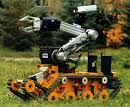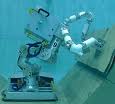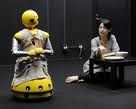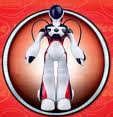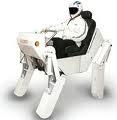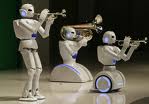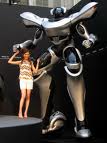Sunday, September 26, 2010
Mars Sojourner
The Mars Pathfinder spacecraft was Launched from Kennedy Space Center on December 4, 1996. It took the Pathfinder about seven months to get to Mars. Once on Mars, the Pathfinder deployed a telerobotic rover named Sojourner. Sojourner was be humanity's first attempt to operate a remote control vehicle on another planet, its primary function being to demonstrate that small rovers can actually operate on Mars. The constraint of the mission was that there was only a once-per-sol (a sol being a day on Mars) opportunity for command and telemetry transmissions between the lander and earth operators. Communications with the rover were not done in real-time because of the approximately 11 minute light-time delay in receiving the signals. Therefore Sojourner needed to be able to carry out its mission with a form of supervised autonomous control where move commands were sent to the rover ahead of time and Sojourner then navigated and safely traversed the rugged Mars terrain to these locations on its own.
In order to further justify such a mission, the Sojourner was responsible for conducting a series of experiments which validated various technologies for an autonomous mobile vehicle. Some of these experiments included deploying an Alpha Proton X-ray Spectrometer (APXS) on rocks and soil to determine the elemental composition and constrain the mineralogy of rocks and other surface materials present at the landing site; imaging the lander, using IMP, as part of an engineering assessment after landing; Mars terrain reconstruction from imagery; basic soil mechanics; dead reckoning sensor performance and path reconstruction; and testing ultra high frequency (UHF) link effectiveness graphed as a function of location by logging data transfer errors.

The Sojourner telecommunications system was a two-way wireless UHF radio link between the Lander and the Rover. This link was used to send commands from Earth to the Rover and receive images and data from the Rover. The Rover communications were not done directly because the Micro rover radio had a signal range similar to a walkie- talkie. The rover's wheels and suspension used a unique system with no springs. Rather, its joints rotated and conformed to the contour of the ground, providing the greatest degree of stability for traversing rocky, uneven surfaces.
In order to further justify such a mission, the Sojourner was responsible for conducting a series of experiments which validated various technologies for an autonomous mobile vehicle. Some of these experiments included deploying an Alpha Proton X-ray Spectrometer (APXS) on rocks and soil to determine the elemental composition and constrain the mineralogy of rocks and other surface materials present at the landing site; imaging the lander, using IMP, as part of an engineering assessment after landing; Mars terrain reconstruction from imagery; basic soil mechanics; dead reckoning sensor performance and path reconstruction; and testing ultra high frequency (UHF) link effectiveness graphed as a function of location by logging data transfer errors.

The Sojourner telecommunications system was a two-way wireless UHF radio link between the Lander and the Rover. This link was used to send commands from Earth to the Rover and receive images and data from the Rover. The Rover communications were not done directly because the Micro rover radio had a signal range similar to a walkie- talkie. The rover's wheels and suspension used a unique system with no springs. Rather, its joints rotated and conformed to the contour of the ground, providing the greatest degree of stability for traversing rocky, uneven surfaces.
Telepresence
 When teleoperation took effect, the robot's progress slowed because of all the sensory information from sensors, laser, and cameras that the humans had to deal with before assigning any particular motion to the robot. Therefore, it was important to the creators of Dante II that there be a graphical representation of all of the sensory information, in order to get an accurate picture of the terrain Dante was covering, and the state of the robot itself. By creating a graphical representation, the operators did not have to manually go through every bit of information Dante sent back from the crater and had a better chance of successfully maneuvering the robot. From this perspective, a robot like Dante II is ideal for exploration, since its sensory information is provided much more quickly and in depth than any human mapping could do. In general, this technique of displaying all the sensory information is called telepresence and has been implemented in many such applications.
When teleoperation took effect, the robot's progress slowed because of all the sensory information from sensors, laser, and cameras that the humans had to deal with before assigning any particular motion to the robot. Therefore, it was important to the creators of Dante II that there be a graphical representation of all of the sensory information, in order to get an accurate picture of the terrain Dante was covering, and the state of the robot itself. By creating a graphical representation, the operators did not have to manually go through every bit of information Dante sent back from the crater and had a better chance of successfully maneuvering the robot. From this perspective, a robot like Dante II is ideal for exploration, since its sensory information is provided much more quickly and in depth than any human mapping could do. In general, this technique of displaying all the sensory information is called telepresence and has been implemented in many such applications.
DANTE II
In 1994, a walking robot named Dante II explored the Alaskan volcano, Mt. Spurr, on its own for nearly a week. The principal objective of Dante II was to develop and demonstrate technologies which could lead to solutions for robotic exploration of rugged terrain on the Moon and planets. The secondary objective of Dante II was to obtain scientific data on Mt. Spurr, as it had never been explored before.
Dante II was not self deploying, which would be a hindrance in potentially dangerous situations and would make space missions impossible. Instead, Dante was tethered at a site on the edge of the volcano during its repelling decent. This tether created maneuvering problems because during operation there was a constant issue of tangling Dante up. In addition to this tether, there was a satellite band communications antenna at this site used to send video and data between the robot and remote base station.

The operators were located about 120 km from the volcano because of the volcano's instability, which allowed for slightly more realistic (i.e. limited) space communications situations. Transmission of large packets of information (teleoperation commands, for instance) caused delays of 30 seconds or more. This made autonimity extremely important for this mission. Mt. Spurr was an ideal location to test close to real life conditions on the moon and other planets as the terrain was very rugged and the communications bandwidth problems.
Dante II was not self deploying, which would be a hindrance in potentially dangerous situations and would make space missions impossible. Instead, Dante was tethered at a site on the edge of the volcano during its repelling decent. This tether created maneuvering problems because during operation there was a constant issue of tangling Dante up. In addition to this tether, there was a satellite band communications antenna at this site used to send video and data between the robot and remote base station.

The operators were located about 120 km from the volcano because of the volcano's instability, which allowed for slightly more realistic (i.e. limited) space communications situations. Transmission of large packets of information (teleoperation commands, for instance) caused delays of 30 seconds or more. This made autonimity extremely important for this mission. Mt. Spurr was an ideal location to test close to real life conditions on the moon and other planets as the terrain was very rugged and the communications bandwidth problems.
HAZBOT
 In the early 1990s, Jet Propulsion Laboratory (JPL) in Pasadena, California began a project in Telerobotics as part of its Emergency Response Robotics Program. The primary objective of the design of HAZBOT was to allow safe exploration of potentially dangerous sites and handling of hazardous materials in conjunction with the Hazardous Materials team HAZMAT. JPL started with a commercially available REMOTEC ANDROS V robot, and added many important features to this robot with input from the JPL fire department for operation in combustible environments. For instance the special chassis and manipulator design allow all areas containing electronics and motors to be positively pressurized in the case of HAZBOT entering a combustible site. In addition, a six-degree-of-freedom manipulator with a 30 pound lift capability allows the robot to perform a variety of tasks including the unlocking and opening of doors. The manipulator also incorporates a parallel jaw gripper with a 60 pound squeeze force and a gas detector to aid in material identification. The on-board computer system, which JPL developed, controls the manipulator, track drives, and camera positioning. In addition it processes information from the temperature pressure and chemical sensors which allows the robot to provide vital information on spill location, magnitude, material type and concentration so a well prepared response team can safely enter the site. Two video cameras, one located on the gripper and the other on a movable pan/tilt platform, provide feedback to the system operator who can then control the robot from an operator control station from a distance away.
In the early 1990s, Jet Propulsion Laboratory (JPL) in Pasadena, California began a project in Telerobotics as part of its Emergency Response Robotics Program. The primary objective of the design of HAZBOT was to allow safe exploration of potentially dangerous sites and handling of hazardous materials in conjunction with the Hazardous Materials team HAZMAT. JPL started with a commercially available REMOTEC ANDROS V robot, and added many important features to this robot with input from the JPL fire department for operation in combustible environments. For instance the special chassis and manipulator design allow all areas containing electronics and motors to be positively pressurized in the case of HAZBOT entering a combustible site. In addition, a six-degree-of-freedom manipulator with a 30 pound lift capability allows the robot to perform a variety of tasks including the unlocking and opening of doors. The manipulator also incorporates a parallel jaw gripper with a 60 pound squeeze force and a gas detector to aid in material identification. The on-board computer system, which JPL developed, controls the manipulator, track drives, and camera positioning. In addition it processes information from the temperature pressure and chemical sensors which allows the robot to provide vital information on spill location, magnitude, material type and concentration so a well prepared response team can safely enter the site. Two video cameras, one located on the gripper and the other on a movable pan/tilt platform, provide feedback to the system operator who can then control the robot from an operator control station from a distance away.
Telerobotics
Telerobotics is the area of robotics concerned with the control of robots from a distance, chiefly using wireless connections (like Wi-Fi, Bluetooth, the Deep Space Network, and similar), "tethered" connections, or the Internet. It is a combination of two major subfields, teleoperation and telepresence.
Telerobotics is a very important and quickly expanding field in the face of faster processors, new algorithms, and higher expectations. There are many important telerobotics applications in use today, ranging from space exploration, to biomedical applications, to hazardous area exploration. The leader in this field is NASA. As NASA looks to more distant stars, there is a need for more advanced technology. In investigating this new technology, NASA is developing commercializable applications which rely upon space telerobotics technologies In so doing NASA hopes to improve the national economic competitiveness of the United States and improve the technology transfer efforts. Applications here on Earth serve the dual purpose of providing the means for test and demonstration in realistic operational test environments. The well understood and easily accessible environments on Earth provide a myriad of possibilities of problems that might occur in space. One of the most useful environments for several of the space applications is undersea environments. As a result, many of the technologies have been put to use underwater.
Telerobots are useful in semi- structured to unstructured environments. They can perform non repetitive tasks with an incomplete model of the task environment. One of the main difficulties encountered with telerobots is the variable time delay between operator and manipulator. For instance, it takes longer for instructions to travel from Earth to Mars, than it would for instructions to travel between two rooms in the same building. In the time that it takes instructions to reach Mars, there could have been a change in environment.
Cartesian coordinate robot

A cartesian coordinate robot (also called linear robot) is an industrial robot whose three principal axes of control are linear (i.e. they move in a straight line rather than rotate) and are at right angles to each other. Among other advantages, this mechanical arrangement simplifies the Robot control arm solution. Cartesian coordinate robots with the horizontal member supported at both ends are sometimes called Gantry robots. They are often quite large.
A popular application for this type of robot is a computer numerical control machine (CNC machine). The simplest application is used in milling and drawing machines where a pen or router translates across an x-y plane while a tool is raised and lowered onto a surface to create a precise design.
Due to the linear nature of their movements, Cartesian robots are inherently more accurate than rotary motion style robots such as the SCARA. However, typical Cartesian robots have offered a trade-off of lower speed for this greater repeatability. In addition, in the past, Cartesian robots have tended to be larger units, requiring bigger workcells that take up more factory floor space. Not any longer.
 The XM3000 Series is our third generation of Cartesian robots and yet another example of how EPSON has listened intently to customer feedback . Available in two standard sizes the XM3064 has a 600 x 400 mm XY work envelope while the XM3106 has a 1000mm x 600mm envelope. Both units come standard with the same style 150mm Z axis and +/- 360 degree tool rotation axis as the E-Series SCARA robots. And, as with the E-Series SCARA Robots, an optional 300mm Z-Axis is also available. The XM3000 is also available in a variety of other sizes and configurations such as 2 and 3 axis models
The XM3000 Series is our third generation of Cartesian robots and yet another example of how EPSON has listened intently to customer feedback . Available in two standard sizes the XM3064 has a 600 x 400 mm XY work envelope while the XM3106 has a 1000mm x 600mm envelope. Both units come standard with the same style 150mm Z axis and +/- 360 degree tool rotation axis as the E-Series SCARA robots. And, as with the E-Series SCARA Robots, an optional 300mm Z-Axis is also available. The XM3000 is also available in a variety of other sizes and configurations such as 2 and 3 axis models
Industrial Robot-3
The machine at left can be called a Cartesian robot, though calling this machine a robot is really stretching the definition of a robot. It is Cartesian because it allows x-y-z positioning. Three linear joints provide the three axes of motion and define the x, y and z planes. This robot is suited for pick and place applications where either there are no orientation requirements or the parts can be pre-oriented before the robot picks them up (such as surface mounted circuit board assembly)
Industrial Robot-2

The robot shown at right is made by an American company, Adept Technology. Adept is America's largest robot company and the world's leading producer of SCARA robots. This is actually the most common industrial robot. SCARA stands for Selective Compliance Articulated (though some folks use Assembly here) Robot Arm. The robot has three joints in the horizontal plane that give it x-y positioning and orientation parallel to the plane. There is one linear joint that supplies the z positioning. This is the typical "pick and place" robot. When combined with a vision system it can move product from conveyor belt to package at a very high rate of speed (think "Lucy and the candies" but way faster).
The robot's joint structure allows it to be compliant (or soft) to forces in the horizontal plane. This is important for "peg in hole" type applications where the robot will actually flex to make up for inaccuracies and allow very tight part fits.
Industrial Robots-1
Modern industrial robots are true marvels of engineering. A robot the size of a person can easily carry a load over one hundred pounds and move it very quickly with a repeatability of +/-0.006 inches. Furthermore these robots can do that 24 hours a day for years on end with no failures whatsoever. Though they are reprogrammable, in many applications (particularly those in the auto industry) they are programmed once and then repeat that exact same task for years.
A six-axis robot like the yellow one below costs about $60,000. What I find interesting is that deploying the robot costs another $200,000. Thus, the cost of the robot itself is just a fraction of the cost of the total system. The tools the robot uses combined with the cost of programming the robot form the major percentage of the cost. That's why robots in the auto industry are rarely reprogrammed. If they are going to go to the expense of deploying a robot for another task, then they may as well use a new robot.
 This is pretty much the typical machine people think of when they think of industrial robots. Fanuc makes this particular robot. Fanuc is the largest maker of these type of robots in the world and they are almost always yellow. This robot has six independent joints, also called six degrees of freedom. The reason for this is that arbitrarily placing a solid body in space requires six parameters; three to specify the location (x, y, z for example) and three to specify the orientation (roll, yaw, pitch for example).
This is pretty much the typical machine people think of when they think of industrial robots. Fanuc makes this particular robot. Fanuc is the largest maker of these type of robots in the world and they are almost always yellow. This robot has six independent joints, also called six degrees of freedom. The reason for this is that arbitrarily placing a solid body in space requires six parameters; three to specify the location (x, y, z for example) and three to specify the orientation (roll, yaw, pitch for example).
If you look closely you will see two cylindrical pistons on the side of the robot. These cylinders contain "anti-gravity" springs that are a big part of the reason robots like these can carry such heavy loads. These springs counter-balance against gravity similar to the way the springs on the garage door make it much easier for a person to lift.
You will see robots like these welding, painting and handling materials.
A six-axis robot like the yellow one below costs about $60,000. What I find interesting is that deploying the robot costs another $200,000. Thus, the cost of the robot itself is just a fraction of the cost of the total system. The tools the robot uses combined with the cost of programming the robot form the major percentage of the cost. That's why robots in the auto industry are rarely reprogrammed. If they are going to go to the expense of deploying a robot for another task, then they may as well use a new robot.
 This is pretty much the typical machine people think of when they think of industrial robots. Fanuc makes this particular robot. Fanuc is the largest maker of these type of robots in the world and they are almost always yellow. This robot has six independent joints, also called six degrees of freedom. The reason for this is that arbitrarily placing a solid body in space requires six parameters; three to specify the location (x, y, z for example) and three to specify the orientation (roll, yaw, pitch for example).
This is pretty much the typical machine people think of when they think of industrial robots. Fanuc makes this particular robot. Fanuc is the largest maker of these type of robots in the world and they are almost always yellow. This robot has six independent joints, also called six degrees of freedom. The reason for this is that arbitrarily placing a solid body in space requires six parameters; three to specify the location (x, y, z for example) and three to specify the orientation (roll, yaw, pitch for example).If you look closely you will see two cylindrical pistons on the side of the robot. These cylinders contain "anti-gravity" springs that are a big part of the reason robots like these can carry such heavy loads. These springs counter-balance against gravity similar to the way the springs on the garage door make it much easier for a person to lift.
You will see robots like these welding, painting and handling materials.






